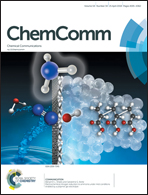Extra thermo- and water-stable one-dimensional organic–inorganic hybrid perovskite [N-methyldabconium]PbI3 showing switchable dielectric behaviour, conductivity and bright yellow-green emission†
Abstract
Haloplumbate-based perovskites display promising functionalities for advanced photovoltaic, optoelectronic and other applications with high performances and low costs. Herein, we present a study of variable-temperature crystal structures, dielectrics and conductance at 153–513 K, and luminescence at ambient temperature for a one-dimensional organic–inorganic perovskite, [N-methyldabconium]PbI3 (1). Hybrid 1 shows extra thermo- and water-stability (thermal decomposition at ca. 653 K), switchable dielectric behaviour and conductance at around 348 K, owing to symmetry-breaking structure phase transition from the hexagonal space group P63/mmc in the high-temperature phase to the orthogonal space group Pcba in the low-temperature phase, and bright yellow-green emission at room temperature, originating from the electron transition within the semiconducting {PbI3}∞ chains. This study will broaden the scope of lead halide-based hybrid materials for practical application in optical and electrical devices.
![Graphical abstract: Extra thermo- and water-stable one-dimensional organic–inorganic hybrid perovskite [N-methyldabconium]PbI3 showing switchable dielectric behaviour, conductivity and bright yellow-green emission](/en/Image/Get?imageInfo.ImageType=GA&imageInfo.ImageIdentifier.ManuscriptID=C8CC00786A&imageInfo.ImageIdentifier.Year=2018)


 Please wait while we load your content...
Please wait while we load your content...